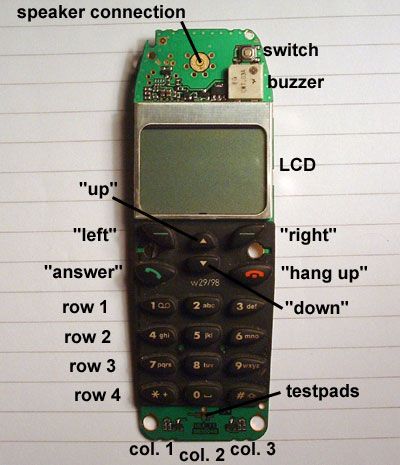I just ran across Jakob Selbing’s instructions on reusing old Nokia cell phone displays via the Make blog. And I just happen to have a whole box of dead phones from that model line; and they look like the interface is the same one as in his article.

This opens a number of interesting possibilities. The display is 84×48 bitmapped pixels, and it has a very simple serial communications format. Jakob’s hack reuses the entire UI (display + keypad) board from the cell phone; but the display itself unclips from that board and could be used independently, by etching appropriate pads onto and cutting appropriate clip holes into a new PCB.
My first thoughts were all the ways I could reuse just the display: for a digital thermostat I’d like to build, for status indication and debugging on robots, for status indication on a CNC drill/mill machine, etc. But this morning on the way to work, I thought of another project I would want to build into an actual entire cell phone case; leaving the keypad, display, and battery; and replacing the “phoneness” board with my own board.
Travel Route Timer
My grandfather kept meticulous logs of times and mileage whenever my dad’s family travelled, and all of Neufeld relatives count things. Seriously, when you get together with Neufelds, it’s perfectly common to hear us caculating how many bricks are in a wall, or estimating how many folding chairs are on the rolling racks in the corner, or determining how big the room must be based on a count of ceiling tiles.
Some ten to fifteen years ago, I was driving to Tulsa as much as once a month to visit a friend who had moved down there. (You can see where this is going already.) It was about a three and a half hour drive, and I thought, wouldn’t it be great to have a little pocket device with some buttons and timers that would show me how long I’d been on the road, how far to the destination, and how far to the next landmark.
I figured I’d enter landmarks on the device OR in advance, then have a list displayed on the trip timer and hit the “HERE” button as I passed each one. If there were room on the screen, it could show me landmark countdown time as well as remaining trip time. It’d need a set of buttons to indicate if I stopped at a rest stop or restaurant, to categorize that as non-driving time that might get counted toward estimates of total trip time but not toward time to next landmark. It would average up my actual road times every time I made the trip, and could develop more and more accurate predictions of trip time and variance. Etc., etc.
At first, I had in mind that it would be a custom gadget. Then when Palm computers were invented and I got a Visor, I always hoped to write a PalmOS program to do it. Alas, it never happened.
Now I’m seeing a new opportunity. Cell phones are a decent size to carry around, and they’re made relatively tough compared to other experimenter case options. The Nokias have an adequate display that I now have information on how to use, and there’s a keypad right there for indicating landmarks passed and maybe even entering the names of new destinations and landmarks. They even come with batteries and chargers!
Plus the idea of taking out the middle PCB of the cell phone–the board that actually makes it a cell phone–and replacing it with a board to do something completely different really appeals to me. The only drawback I see is lack of an obvious way to sync it to a PC for offline landmark entry and persistent data storage and analysis.
Hmm . . .
Addendum
The specific incident this morning that made me think of this project was wondering how fast I was going. I’m test-driving a vehicle today, and it just had the speedometer sensor replaced. I drive the speed limit and am used to getting passed on the highway, but this morning it seemed as though I was getting passed a lot more than usual.
I’d want this device to have a speed-check mode, in which I press the button every time I pass a mile marker, and it calculates and displays how fast I’m actually going.
For a small cost ($6-15) you can get a USB data cable that will connect almost any phone to an unused USB port on your computer. There is also software for syncing your phone address, etc. with your computer.
True–but such a cable relies on circuitry in the cell phone provided by the board I want to remove and replace. I don’t have a way to build a USB interface for the microcontroller I was thinking of using for this project, nor (unfortunately) do I know enough to make a custom USB travel-data sync program for the PC.
On the other hand, that’s a possible idea for a cable source. I could use the cell phone’s connector and a cable like that, but replace the connector at the PC end and run serial communications over it (which I _am_ prepared to program). I like it.